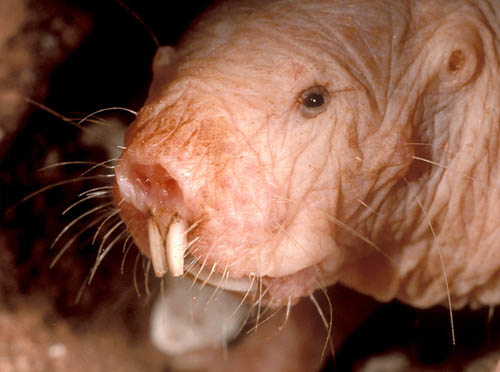ResveratrolConsumer
avert online
consumer fraud
ResveratrolQuiz
test your knowledge
New E-Book
How the world got lost on
the road to an anti-aging pill
Subscribe to our newsletter to receive email notifications when new articles are posted.
August 29, 2009: by ResveratrolNews
Journal Comparative Physiology B (2008) 178:439–445
It may be difficult for humans to fathom that there is a African rodent that doesn’t age, is rarely ill, doesn’t get cancer, diabetes, or experience bone loss with advancing age, and whose females continuously produce babies and don’t experience a “change of life.” This tunneling rat outlives other rodents by ten fold. Your average pet lab rat lives ~3 years, this rodent 28-30 years!
Welcome to the world of the naked mole rat. Naked refers to its hairless pink skin.

Negligible senescence is what biologists call it — no observable aging changes like seen among humans — visibly evident after the fourth decade of life with the need for reading glasses, the loss of hair and wrinkling of skin and the inability to produce offspring.
Even in the wild these subterranean rodents live for more than 28 years, nearly 10-times more than a well cared for laboratory rat, and they simply don’t age. There is no gradual increase in mortality. They remain lean for most of their years compared to the increase in girth humans experience as they age. No spontaneous cancer has ever been observed among naked mole rats kept in the laboratory.
The longevity charts provide a striking picture of the life of naked mole rat. Compared to other rodents, its maximum species life span as predicted from the relationship between its body size and maximum life span, exceeds that of other long-lived animals such as whales, dolphins and porpoises (cetaceans) and bats. The naked mole rat lives nearly 5 times longer than expected when calculating body mass.
The naked mole rat has birthdays but doesn’t experience a decline in physiological function. Examine the chart below.
A remarkable exhibition of perpetual youthfulness is displayed in the naked mole rats’ arteries which remain elastic and flexible to the point where they don’t experience inability to dilate (widen) and control blood pressure with advancing age. Notice the chart above, which shows virtually zero loss of arterial tone. When these animals are administered acetycholine, a chemical that dilates blood vessels, their arteries widen as well at age 12 years as they did at age 2 years.
Furthermore, these tunneling rats maintain their bone mass throughout life and do not develop age-related insensitivity to insulin which results in dysfunctional blood sugar control. Examine the chart below which reveals these animals simply don’t age.
| Naked mole-rat | Mice and rats | |
|---|---|---|
| Basal metabolic rate | Unchanged | Declines |
| Vascular relaxation | Unchanged | Declines |
| Bone cortical area | Unchanged | Declines |
| Bone mineral density | Unchanged | Declines |
| Articular cartilage | Unchanged | Declines |
| ROS production | Unchanged | Increases |
| Antioxidant activity | Unchanged | Increases |
| Oxidative damage | Unchanged | Increases |
| Glucose tolerance | Unchanged | Declines |
| Glycated hemoglobin | Unchanged | Declines |
How does the naked mole remain young throughout its life? It’s only the female naked mole rats that exhibit long-lasting youthfulness. The females continually menstruate and produce offspring, preventing age-related accumulation of minerals such as iron, copper and calcium by virtue of their monthly loss of blood and their donation of minerals to their offspring during pregnancy and lactation. Female naked mole rats do not rust and calcify as do other rodents with advancing age.
To learn more about the overmineralization theory of aging, visit www.longevinex.com
Copyright 2009 Bill Sardi, Resveratrol News.com No reproduction of posting elsewhere
Posted in Resveratrol
Add comments »